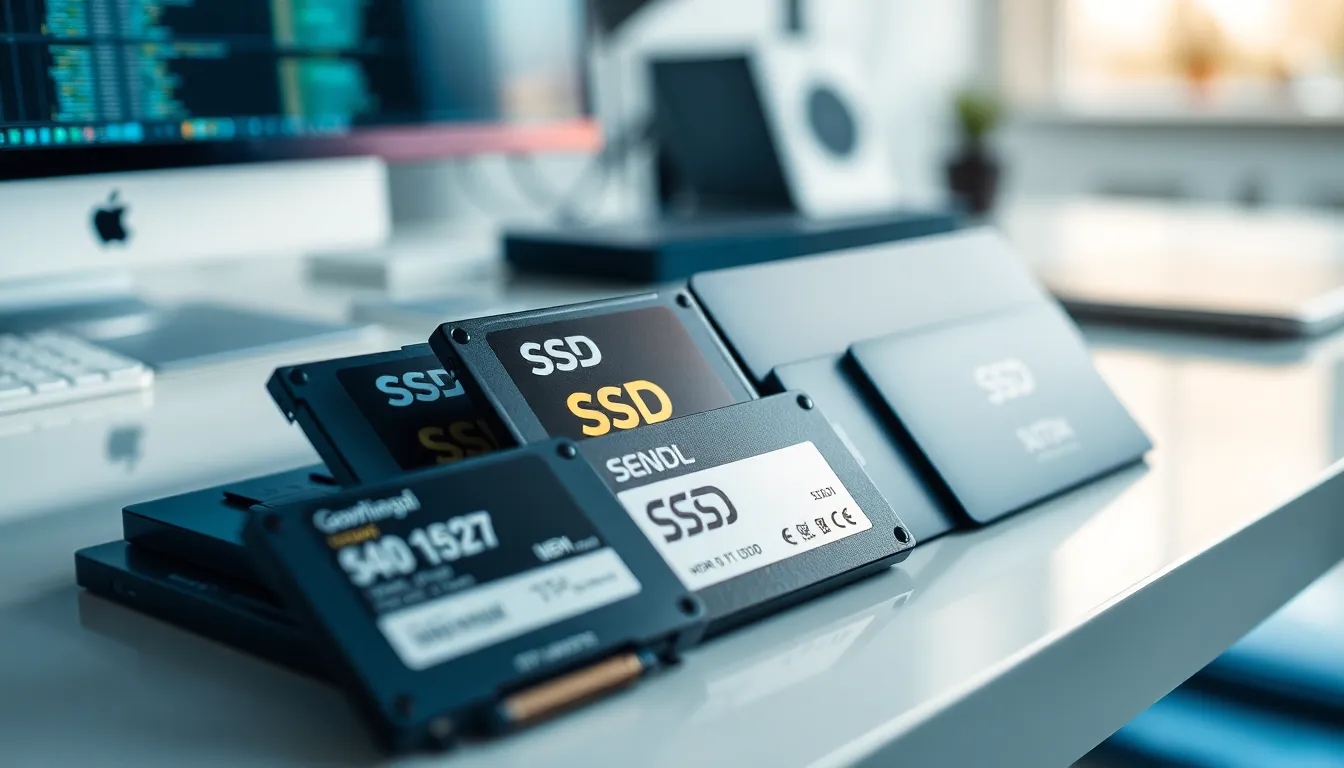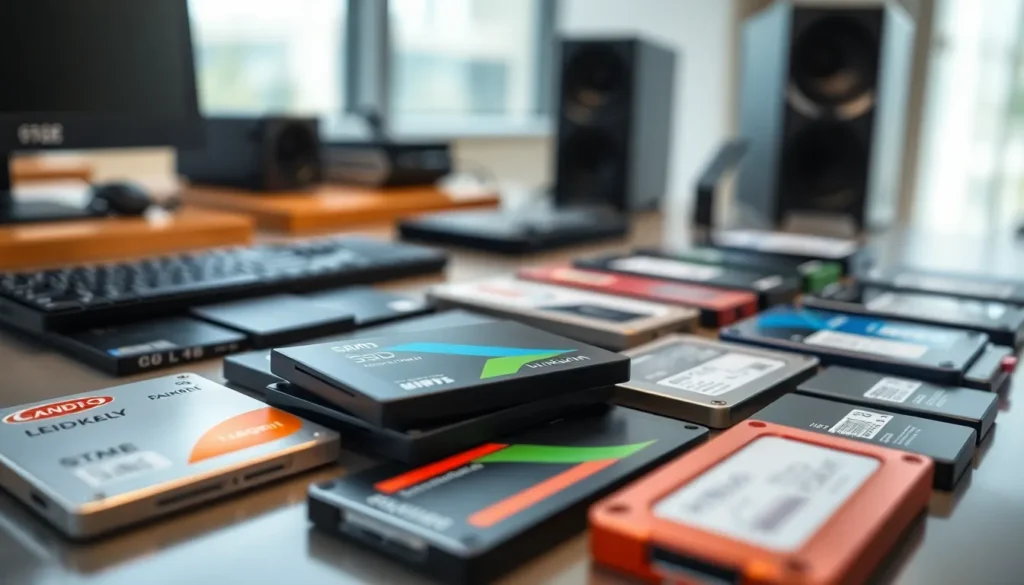Table of Contents
ToggleSolid State Drives (SSDs) have revolutionized the way people store and access data, offering speed and reliability that traditional hard drives can’t match. As technology continues to evolve, the demand for SSDs has surged, leading to fluctuations in pricing that can confuse consumers. Understanding these price trends is crucial for anyone looking to upgrade their devices or build a new system.
In recent years, SSD prices have seen significant changes due to various factors, including advancements in manufacturing processes and global supply chain issues. This article explores the current landscape of SSD pricing, delving into what drives these costs and how consumers can make informed purchasing decisions. Whether you’re a gamer, a professional, or just someone looking to enhance their computer’s performance, knowing the ins and outs of SSD prices can help you get the best value for your investment.
Overview of SSD Prices
SSD prices fluctuate significantly based on multiple factors, including storage capacity, technology type, brand reputation, and market demand.
Average Prices
- 120GB to 256GB: Prices typically range from $20 to $60.
- 512GB: Average costs fall between $50 and $120.
- 1TB: Consumers can expect to pay around $90 to $200.
- 2TB and above: Prices often exceed $200, reaching up to $400 for high-end models.
Factors Influencing Prices
- Manufacturing Advances: New technologies and production methods can lower costs, impacting retail prices.
- Supply Chain Issues: Global supply disruptions can lead to price increases during high-demand periods.
- Brand Competition: Increased competition among manufacturers affects pricing strategies.
Price Trends
Price trends indicate a general decline over the past few years. Data shows SSD prices dropped by nearly 20% annually, influenced by increased production and evolving technology. Seasonal promotions may further lower prices, especially during Black Friday and back-to-school periods.
Understanding SSD pricing helps consumers make informed decisions, optimizing their investments in storage technology.
Factors Influencing SSD Prices

Several factors influence SSD prices, including storage capacity, brand reputation, and technology advancements. Understanding these aspects helps consumers navigate pricing trends effectively.
Storage Capacity
Storage capacity plays a significant role in SSD pricing. Larger capacities typically command higher prices due to increased manufacturing costs. For instance, a 2TB SSD often exceeds $200, while a 120GB model may range from $20 to $60. Pricing structures generally align with the following:
| Storage Capacity | Price Range |
|---|---|
| 120GB to 256GB | $20 to $60 |
| 512GB | $50 to $120 |
| 1TB | $90 to $200 |
| 2TB and above | $200+ |
| High-end models | Up to $400 |
Brand Reputation
Brand reputation also affects SSD pricing. Well-known brands, such as Samsung and Crucial, often charge premium prices due to established trust and quality assurance. Consumers tend to associate higher prices with superior performance and reliability, making brand selection a critical consideration when choosing SSDs. Lesser-known brands may offer competitive pricing, but the perceived risk of lower quality can deter some buyers.
Technology Advancements
Technology advancements significantly impact SSD prices. Emerging technologies, such as NVMe (Non-Volatile Memory Express), provide faster data transfer speeds, which can lead to higher price points compared to SATA-based SSDs. As manufacturing processes improve, costs decrease, contributing to overall price reductions. Recent trends show an annual price drop of nearly 20%, attributed to these technological innovations, increased production capacities, and greater competition among manufacturers.
Comparing SSD Prices Across Different Brands
The SSD market features several prominent brands, each offering unique pricing structures and technologies. Analyzing these differences helps consumers make informed choices.
Major Players in the Market
- Samsung
Samsung leads the SSD market with a wide range of products, known for superior performance and reliability. Pricing for Samsung SSDs generally ranges from $50 for basic models to over $400 for high-capacity options.
- Crucial
Crucial, a branch of Micron, offers budget-friendly SSDs without sacrificing quality. Prices typically range from $30 for smaller capacities to around $150 for 1TB models.
- Western Digital
Western Digital provides versatile SSDs suitable for various use cases. Prices vary from $50 for entry-level models to $250 for performance-oriented options.
- Kingston
Kingston focuses on reliability and affordability, with prices starting at $25 for basic options and reaching up to $200 for higher performance SSDs.
- Intel
Intel’s SSDs often cater to professionals and gamers, featuring higher price points, ranging from $100 to $350, depending on specifications.
Price Variations by Type
- SATA SSDs
SATA-based SSDs remain the most affordable option, with prices ranging from $20 to $100 for capacities from 120GB to 1TB. Their slower data transfer rates make them suitable for general use.
- NVMe SSDs
NVMe SSDs are typically pricier due to their advanced technology, offering faster data transfer speeds. Prices often range from $50 for basic models to over $400 for high-capacity solutions.
- M.2 and PCIe SSDs
M.2 and PCIe SSDs provide compact designs and higher speed capabilities. Pricing ranges from $60 for entry-level options to around $300 for high-performance models.
- External SSDs
External SSDs provide portability, with prices ranging from $40 to $300, depending on speed and capacity. They serve well for on-the-go storage solutions.
- Enterprise SSDs
Enterprise-grade SSDs cater to business needs with higher endurance and performance. Prices often exceed $500, reflecting advanced technology and reliability suitable for heavy workloads.
Trends in SSD Pricing
In recent years, SSD pricing has shown notable trends attributed to various market dynamics. Prices fluctuate based on several factors, including storage capacity, technology types, and brand competition.
Price Ranges for Different Capacities:
| Storage Capacity | Price Range |
|---|---|
| 120GB – 256GB | $20 – $60 |
| 512GB | $50 – $120 |
| 1TB | $90 – $200 |
| 2TB and above | $200 and up, often up to $400 |
Key Factors Influencing SSD Prices:
- Manufacturing Advancements: Production efficiencies have driven down costs. New techniques and materials in SSD production yield more units at lower prices.
- Supply Chain Issues: Disruptions can lead to price spikes due to scarcity. Global events affecting transport and raw material availability can impact overall pricing.
- Brand Competition: Variety among brands fosters varying price points. Established brands may demand higher prices due to trust and perceived quality, while new entrants often provide more accessible options.
Technological Impact:
Emerging technologies like NVMe, which offer enhanced performance, often command higher prices than traditional SATA SSDs. Users seeking speed and efficiency tend to pay premiums for these advanced options.
Seasonal Pricing Trends:
Promotions and sales events may lead to temporary price reductions, particularly around holiday seasons, which represent opportunities for consumers to purchase SSDs at lower prices.
Overall, understanding these trends in SSD pricing helps consumers make informed choices and enhances their value in storage technology investments.
Navigating the SSD pricing landscape can be challenging for consumers. With prices influenced by various factors it’s essential to stay informed. The ongoing advancements in technology and manufacturing processes continue to drive down costs while brand competition creates a diverse market.
Understanding these dynamics empowers buyers to make smart purchasing choices. Whether looking for budget-friendly options or high-performance drives consumers can leverage seasonal promotions and sales to maximize their investments. As SSD technology evolves the future looks promising for both affordability and performance in data storage solutions.




